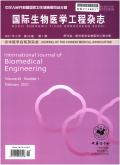Significance of lymphovascular invasion in pT1 squamous differentiated bladder urothelial carcinoma
引用次数: 0
Abstract
Objective To systematically evaluate the prognostic significance of lymphovascular invasion (LVI) in pT1 stage bladder urothelial carcinoma with squamous differentiation. Methods The clinical and patho-logical data of 105 patients with pT1 stage urothelial carcinoma with squamous differentiation and transurethral re-section of bladder tumor (TURBT) were retrospectively analyzed. Hematoxylin-eosin staining and immunohisto-chemical staining were used to determine the presence of LVI in tumor tissues. All patients were divided into LVI-negative group and LVI-positive group according to LVI. The relationship between LVI and clinicopathological fea-tures and 5-year cancer-specific survival (CSS) rate was analyzed. Patients with relapse were divided into TURBT group and radical cystectomy (RC) group according to the surgical method, and the effects of the methods on CSS were compared. Results There are 57 patients (27.6%) had LVI. In the LVI-negative group, the 5-year CSS was 84.9%, while that in the LVI-positive group was 58.4%, the difference was statistically significant(P<0.05). Univari-ate analysis showed that tumor multiple appearance, tumor size, recurrence and LVI were significantly correlated with CSS (all P<0.05). Multivariate analysis showed that tumor size and LVI had significant effects on CSS (all P<0.05). In the relapsed patients with LVI-positive, RC had a higher CSS than TURBT (P=0.042). In the relapsed pa-tients with LVI-negative, the difference between the two methods was not statistically significant(P=0.692). Conclusions LVI is an important prognostic factor in pT1 stage urothelial carcinoma with squamous differentiation. Pa-tients with LVI and tumor size >3 cm have a higher risk of death. Patients with pT1 stage urothelial carcinoma with squamous differentiation, especially those with LVI, should be treated with RC as soon as possible. Key words: Bladder neoplasms; Lymphovascular invasion; Squamous metaplasia; Prognosis; Radical cystectomy淋巴管浸润在pT1鳞状分化膀胱尿路上皮癌中的意义
目的系统评价pT1期膀胱尿路上皮癌伴鳞状分化的淋巴血管浸润(LVI)对预后的影响。方法回顾性分析105例pT1期尿路上皮癌伴鳞状分化经尿道膀胱肿瘤切除术(turt)的临床及病理资料。采用苏木精-伊红染色和免疫组化染色检测肿瘤组织中LVI的存在。根据LVI将患者分为LVI阴性组和LVI阳性组。分析LVI与临床病理特征及5年肿瘤特异性生存率(CSS)的关系。复发患者根据手术方式分为TURBT组和根治性膀胱切除术(radical cystectomy, RC)组,比较两种手术方式对CSS的影响。结果LVI患者57例,占27.6%。lvi阴性组5年CSS为84.9%,lvi阳性组5年CSS为58.4%,差异有统计学意义(P3 cm死亡风险较高)。pT1期尿路上皮癌伴鳞状分化的患者,尤其是LVI患者,应尽快接受RC治疗。关键词:膀胱肿瘤;Lymphovascular入侵;鳞状上皮化生;预后;根治
本文章由计算机程序翻译,如有差异,请以英文原文为准。
求助全文
约1分钟内获得全文
求助全文

 求助内容:
求助内容: 应助结果提醒方式:
应助结果提醒方式:


